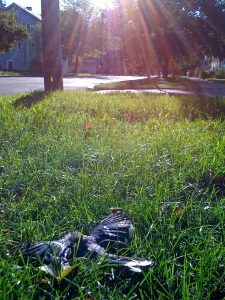Last fall my neighbor Karen Rodriguez, a photographer and filmmaker (check out her blog here), took this killer photo with her phone. Its beauty needs no explanation, but I was stunned by the latent symbolism of the lifeless bird showered by the sun, rays of spectral color and life.
You see, not long before, I had written a series of articles on ancient myths, which led me to scholarship on the archeological evidence suggesting the widespread ancient practice of goddess worship.
Many feminists and scholars of women’s history know that some archaeologists and anthropologists believe that goddess worship was common in many parts of the world in prehistoric and even early historic times. But for those folks unfamiliar with this history: In the 20th century, researchers discovered what they believed to be undeniable material evidence of goddess worship and matriarchal religions from the Paleolithic (2.6 million years ago) into the Neolithic (approx. 10000 to 4000-2000 BCE) eras, in parts of Africa, in Western Europe, the Mediterranean, and other places.
A renowned 20th century archeologist who supported this claim was Marija Gimbutas, a Lithuanian-American archeologist who excavated many sites around Europe to make these discoveries. Gimbutas unearthed countless objects of worship that she believed represented female animal deities, including snakes, birds, bees, bears, and others. She also claimed that certain of these figures reflected the worship of a “Great Goddess,” a figure representing the source of both life and death.
Now it must be said that Gimbutas’ work, which scholars like Miriam Robbins Dexter have continued since her death in 1994, is not universally accepted because some archaeologists claim that she did not sufficiently support her interpretations.
But the evidence of goddess worship itself is undeniable, and it is fairly clear that the Greek goddesses Athena, Aphrodite, Hera, and Artemis originally played far more powerful roles than the soap-opera bit parts they ended up with. Artemis (later Diana for the Romans) is especially intriguing because she appears to have retained much of her original features even in patriarchal Greek mythology. There, she is a wild virgin huntress and the sister of Apollo. Homer calls her the “mistress of animals.”
She was also believed to assist women in childbirth, but she was often savage and merciless, ever ready to slaughter or punish disloyal worshippers. Gimbutas and others believe that Artemis’ virgin and sister roles were later patriarchal additions and that she is a descendent of both the ancient animal goddesses and the Goddess of Life and Death, both giver and taker of life.
Especially fascinating is Gimbutas’ claim that the figurines, murals, temple remains, and other evidence of this goddess figure suggest a cultural attitude that is totally unlike our modern tendency to categorically separate life and death: today, many cultures revere life as much as they revile aging and death, encouraging people to deny and even defy death by any means possible. For prehistoric people, life and death appear to have been connected as part of a natural continuum that included regeneration.
This modern hatred of death, argued Gimbutas, ultimately stems from the Indo-European patriarchal cultures that arrived in Europe in the Bronze Age and replaced the goddess-centered societies with worship of a male sky god. Reviling death encouraged a deep fear of this basic fact of life and a consequent impulse to control and dominate life, which meant land and women, the two chief representatives of its source.
Domination indeed. Here we are today with carbon dioxide levels above 400 parts per million, the milestone “long-feared” by scientists.
Whatever the source of the dominant patriarchal cultures of the last several thousand years, it’s pretty undeniable that climate change is a direct result of patriarchal attempts to dominate and abuse the earth.
So. When exactly can we agree that the whole domination thing hasn’t worked out so well?
I’m not sure we will figure it out in time: It might already be too late to deal with this crisis and ensure a viable future for humans on earth.
But that’s no reason to give up: the patriarchal religions that have justified endless war and profit are unsustainable. We need new systems of belief. Like now.
If this sounds nuts, naïve, or both, consider that the strength of Christianity has waned considerably over the last few centuries. I’m not convinced that we will necessarily see a radical change in religion in the near future, but change is not as impossible as it might seem. Overall, the Judeo-Christian tradition is relatively young, and Christianity is a mere two-thousand years old – a drop in the bucket in evolutionary terms.
And consider that the old goddess religions were quite difficult to eradicate. The worship of Artemis, and later Diana, lasted well into patriarchal times, proving her immense popularity. According to one biblical legend, when Paul (New Testament writer) came to Ephesus to preach the word of Christ, he was shouted down for hours by the people, who chanted over and over, “Great is Diana of Ephesus!”
The Virgin Mary, demoted by Protestant sects, is certainly the ancestor of the ancient mother-goddess figures – figures who could not be wiped out and so were preserved in different form.
I have no ingenious answers for how to start shifting culture toward spiritual beliefs that would encourage more viable ways of living.
But today is Mother’s Day in many parts of the world, and Karen’s brilliant photo seems like a fine offering for maternal spirits everywhere. I call it a late vestige of the ancient goddess who – if Gimbutas and others are right – was far more sage about life and death than we have managed to be.
Who knows when late vestiges might become early signs?

